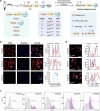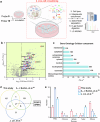Development of nucleus-targeted histone-tail-based photoaffinity probes to profile the epigenetic interactome in native cells
- PMID: 39762271
- PMCID: PMC11704063
- DOI: 10.1038/s41467-024-55046-8
Development of nucleus-targeted histone-tail-based photoaffinity probes to profile the epigenetic interactome in native cells
Abstract
Dissection of the physiological interactomes of histone post-translational modifications (hPTMs) is crucial for understanding epigenetic regulatory pathways. Peptide- or protein-based histone photoaffinity tools expanded the ability to probe the epigenetic interactome, but in situ profiling in native cells remains challenging. Here, we develop a nucleus-targeting histone-tail-based photoaffinity probe capable of profiling the hPTM-mediated interactomes in native cells, by integrating cell-permeable and nuclear localization peptide modules into an hPTM peptide equipped with a photoreactive moiety. These types of probes, such as histone H3 lysine 4 trimethylation and histone H3 Lysine 9 crotonylation probes, enable the probing of epigenetic interactomes both in HeLa cell and hard-to-transfect RAW264.7 cells, resulting in the discovery of distinct interactors in different cell lines. The utility of this probe is further exemplified by characterizing interactome of emerging hPTM, such as AF9 was detected as a binder of histone H3 Lysine 9 lactylation, thus expanding the toolbox for profiling of hPTM-mediated PPIs in live cells.
© 2024. The Author(s).
Conflict of interest statement
Competing interests: The authors declare no competing interests.
Figures






Similar articles
-
Development of a DNA-Templated Peptide Probe for Photoaffinity Labeling and Enrichment of the Histone Modification Reader Proteins.Angew Chem Int Ed Engl. 2016 Jul 4;55(28):7993-7. doi: 10.1002/anie.201602558. Epub 2016 May 12. Angew Chem Int Ed Engl. 2016. PMID: 27169517
-
An Efficient Approach for Selective Enrichment of Histone Modification Readers Using Self-Assembled Multivalent Photoaffinity Peptide Probes.Anal Chem. 2018 Oct 2;90(19):11385-11392. doi: 10.1021/acs.analchem.8b02342. Epub 2018 Sep 19. Anal Chem. 2018. PMID: 30188686
-
Deciphering the Interactome of Histone Marks in Living Cells via Genetic Code Expansion Combined with Proximity Labeling.Anal Chem. 2022 Aug 2;94(30):10705-10714. doi: 10.1021/acs.analchem.2c01042. Epub 2022 Jul 21. Anal Chem. 2022. PMID: 35862615
-
Histone H3 lysine methylation in cognition and intellectual disability disorders.Learn Mem. 2013 Sep 17;20(10):570-9. doi: 10.1101/lm.029363.112. Learn Mem. 2013. PMID: 24045506 Review.
-
[The roles of histone lysine methylation in epigenetic regulation].Yi Chuan. 2007 Apr;29(4):387-92. doi: 10.1360/yc-007-0387. Yi Chuan. 2007. PMID: 17548299 Review. Chinese.
Cited by
-
Advances in the chemical synthesis of human proteoforms.Sci China Life Sci. 2025 Apr 8. doi: 10.1007/s11427-024-2860-5. Online ahead of print. Sci China Life Sci. 2025. PMID: 40210795 Review.
-
Lactate Metabolism and Lactylation Modification: New Opportunities and Challenges in Cardiovascular Disease.MedComm (2020). 2025 Jul 1;6(7):e70269. doi: 10.1002/mco2.70269. eCollection 2025 Jul. MedComm (2020). 2025. PMID: 40599233 Free PMC article. Review.
References
-
- Kouzarides, T. Chromatin modifications and their function. Cell128, 693–705 (2007). - PubMed
-
- Lin, J. et al. Menin “reads” H3K79me2 mark in a nucleosomal context. Science379, 717–723 (2023). - PubMed
-
- Boichenko, I. & Fierz, B. Chemical and biophysical methods to explore dynamic mechanisms of chromatin silencing. Curr. Opin. Chem. Biol.51, 1–10 (2019). - PubMed
MeSH terms
Substances
LinkOut - more resources
Full Text Sources

